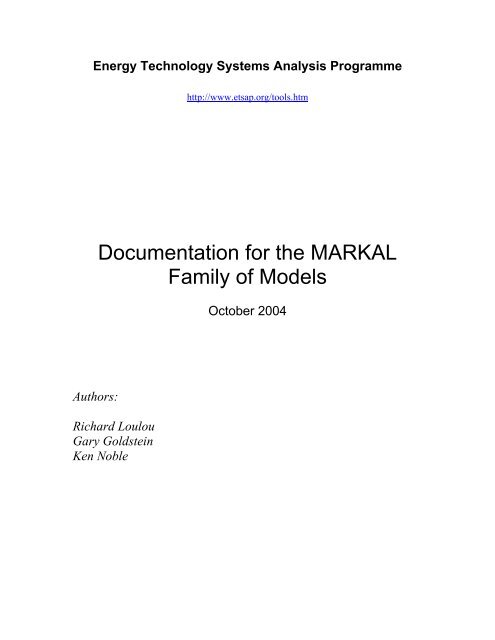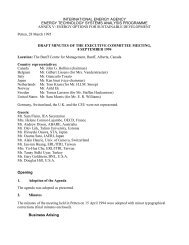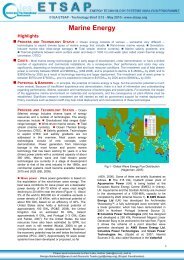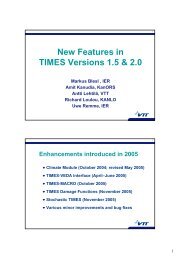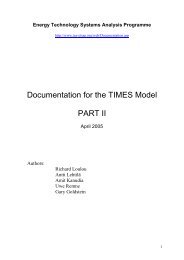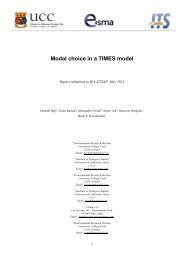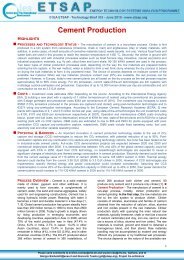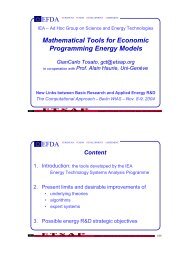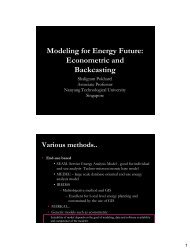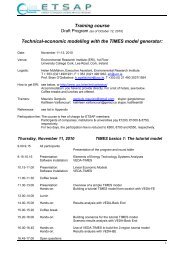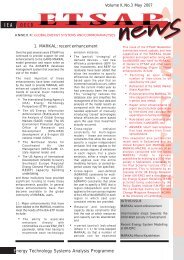Documentation for the MARKAL Family of Models - iea-etsap
Documentation for the MARKAL Family of Models - iea-etsap
Documentation for the MARKAL Family of Models - iea-etsap
You also want an ePaper? Increase the reach of your titles
YUMPU automatically turns print PDFs into web optimized ePapers that Google loves.
Energy Technology Systems Analysis Programme<br />
http://www.<strong>etsap</strong>.org/tools.htm<br />
<strong>Documentation</strong> <strong>for</strong> <strong>the</strong> <strong>MARKAL</strong><br />
<strong>Family</strong> <strong>of</strong> <strong>Models</strong><br />
October 2004<br />
Authors:<br />
Richard Loulou<br />
Gary Goldstein<br />
Ken Noble
Part II: <strong>MARKAL</strong>-MACRO<br />
3. Concepts and Theory .................................................................................389<br />
3.1 Introduction....................................................................................................................389<br />
3.2 Formulation <strong>of</strong> <strong>MARKAL</strong>-MACRO............................................................................390<br />
3.2.1 The Macroeconomic equations (MACRO Module) .....................................................390<br />
3.2.2 The <strong>MARKAL</strong> and Linking Equations.........................................................................392<br />
3.3 Calibration and o<strong>the</strong>r modeling issues.........................................................................393<br />
3.3.1 Production Function Parameters...................................................................................393<br />
3.3.2 Demands .......................................................................................................................394<br />
3.3.3 Energy Costs .................................................................................................................394<br />
3.3.4 Utility discount rates.....................................................................................................394<br />
3.4 O<strong>the</strong>r Modeling Issues...................................................................................................395<br />
3.4.1 Increasing period length via COLLAPSE.....................................................................395<br />
3.4.2 Differential Costing ......................................................................................................395<br />
4. Reference Guide <strong>for</strong> <strong>MARKAL</strong>-MACRO...............................................397<br />
4.1 Sets, Switches and Parameters......................................................................................397<br />
4.2 <strong>MARKAL</strong>-MACRO Variables.....................................................................................404<br />
4.3 <strong>MARKAL</strong>-MACRO Equations ....................................................................................404<br />
4.3.1 MR_COSTNRG(r,t)......................................................................................................405<br />
4.3.2 MR_DD(r,d,t) ...............................................................................................................407<br />
4.3.3 MR_IVECBND(r,t) ......................................................................................................407<br />
4.3.4 MR_MCAP(r,t).............................................................................................................408<br />
4.3.5 MR_MPEN(r,p,t) ..........................................................................................................409<br />
4.3.6 MR_TMC(r,t)................................................................................................................410<br />
4.3.7 MR_UTIL .....................................................................................................................410<br />
4.3.8 MR_XCAPBD(r,t,p).....................................................................................................411<br />
4.4 Appendix A: <strong>the</strong> Demand Decoupling Factor (DDF) Utility .....................................413<br />
4.5 Appendix B: The Adder Procedure..............................................................................417<br />
387
List <strong>of</strong> tables<br />
Table 4-1. Definition <strong>of</strong> <strong>MARKAL</strong>-MACRO user input data .................................................398<br />
Table 4-2. <strong>MARKAL</strong>-MACRO-specific matrix coefficients and internal model<br />
parameters.........................................................................................................................402<br />
Table 4-3. <strong>MARKAL</strong>-MACRO variables ................................................................................404<br />
Table 4-4. MACRO Model constraints.....................................................................................405<br />
List <strong>of</strong> figures<br />
Figure 3-1. The <strong>MARKAL</strong>-MACRO flows .............................................................................390<br />
388
3. Concepts and Theory<br />
3.1 Introduction<br />
<strong>MARKAL</strong>-MACRO (Manne and Wene, 1992) is <strong>the</strong> result <strong>of</strong> merging two existing<br />
model approaches into a single, self-contained new model. On <strong>the</strong> one hand, <strong>the</strong>re is <strong>the</strong><br />
<strong>MARKAL</strong> model (see PART I), with its detailed, explicit technological representation.<br />
On <strong>the</strong> o<strong>the</strong>r hand, <strong>the</strong>re is MACRO (Manne and Richels, 1992), a succinct, single sector,<br />
optimal growth dynamic inter-temporal general equilibrium model, based on <strong>the</strong><br />
maximization <strong>of</strong> a national utility function. Merging <strong>the</strong>se two models results in a new<br />
model that captures <strong>the</strong> characteristics <strong>of</strong> an intertemporal general equilibrium model,<br />
while retaining <strong>the</strong> rich technological detail <strong>of</strong> <strong>MARKAL</strong>. The equilibrium is based on<br />
<strong>the</strong> assumption <strong>of</strong> perfect <strong>for</strong>esight and competitive markets, in <strong>the</strong> sense <strong>of</strong> neo-classical<br />
economic <strong>the</strong>ory. The economic agents in <strong>MARKAL</strong>-MACRO are: <strong>the</strong> generic suppliers<br />
and consumers <strong>of</strong> energy (as in <strong>MARKAL</strong>), plus <strong>the</strong> o<strong>the</strong>r suppliers <strong>of</strong> goods and<br />
services (regrouped into a single representative producing sector), <strong>the</strong> consumers<br />
(regrouped into a single generic consumer), and a simplified, generic capital market.<br />
Government is not represented as such in <strong>MARKAL</strong>-MACRO. Export markets may be<br />
represented if a multi-regional <strong>MARKAL</strong>-MACRO model is constructed.<br />
A precursor <strong>of</strong> this approach is ETA-MACRO (Manne and Richels 1992), where <strong>the</strong><br />
ETA module was however a less detailed energy supply module than <strong>MARKAL</strong> is. ETA-<br />
MACRO was subsequently used as a component <strong>of</strong> <strong>the</strong> MERGE model (Manne et al.<br />
1995), a global multi-regional G.E. model with emphasis on modeling global emissions<br />
and concentrations <strong>of</strong> Greenhouse Gases.<br />
The linkage between <strong>MARKAL</strong> and MACRO is done at <strong>the</strong> level <strong>of</strong> demands <strong>for</strong> energy<br />
services. In <strong>MARKAL</strong> <strong>the</strong>se demands are specified exogenously in <strong>the</strong> reference case,<br />
and are <strong>the</strong>n endogenously altered by <strong>the</strong> model <strong>for</strong> alternate scenarios, as long as ownprice<br />
elasticities <strong>for</strong> <strong>the</strong> energy service demands are specified by <strong>the</strong> user. In <strong>MARKAL</strong>-<br />
MACRO, a different approach is used: <strong>the</strong> demands are variables <strong>of</strong> <strong>the</strong> model that are<br />
aggregated to become <strong>the</strong> Energy input into <strong>the</strong> MACRO production function, alongside<br />
Labor and Capital. Figure 3-1 shows <strong>the</strong> links between <strong>the</strong> <strong>MARKAL</strong> and MACRO<br />
modules <strong>of</strong> <strong>the</strong> new model. The solid lines indicate physical flows, whereas <strong>the</strong> dashed<br />
lines indicate monetary flows. The <strong>MARKAL</strong> module thus provides one physical input to<br />
<strong>the</strong> MACRO module (aggregate energy), and <strong>the</strong> MACRO module provides one<br />
monetary input to <strong>the</strong> <strong>MARKAL</strong> module (energy cost).<br />
We now provide a full <strong>for</strong>mulation <strong>of</strong> <strong>the</strong> model. Much <strong>of</strong> <strong>the</strong> material in this chapter is<br />
taken from Manne and Wene (1992), which provides additional detail to <strong>the</strong> interested<br />
reader.<br />
389
ENERGY COST<br />
<strong>MARKAL</strong><br />
AGGREGATE<br />
ENERGY<br />
MACRO<br />
PRODUCTION<br />
CONSUMPTION<br />
LABOR<br />
NEW CAPITAL<br />
INVESTMENTS<br />
Figure 3-1. The <strong>MARKAL</strong>-MACRO flows<br />
3.2 Formulation <strong>of</strong> <strong>MARKAL</strong>-MACRO<br />
<strong>MARKAL</strong>-MACRO consists <strong>of</strong> Macroeconomic equations and variables (Macro<br />
module), <strong>MARKAL</strong> equations and variables (<strong>MARKAL</strong> module), and Linking equations.<br />
3.2.1 The Macroeconomic equations (MACRO Module)<br />
The MACRO part <strong>of</strong> <strong>the</strong> model is a one-sector neoclassical growth model (see Allen<br />
1968) based on <strong>the</strong> maximization <strong>of</strong> a utility function subject to a national budget<br />
constraint. National output is produced by a single sector, represented by a nested<br />
production function with constant elasticities <strong>of</strong> substitution between three inputs (Labor,<br />
Capital, Energy).<br />
• The utility function is <strong>the</strong> discounted present value (at year 1) <strong>of</strong> <strong>the</strong><br />
logarithms <strong>of</strong> <strong>the</strong> aggregate consumptions at each period, with an end-<strong>of</strong>horizon<br />
term to account <strong>for</strong> utility accrued after <strong>the</strong> end <strong>of</strong> <strong>the</strong> planning<br />
horizon. It is expressed as (1.2-1) below.<br />
• The national budget equation expresses that national production may be used<br />
<strong>for</strong> consumption, investments, and energy costs. This is expressed as (1.2-2).<br />
• The national production results from three substitutable inputs: Capital, Labor,<br />
and Energy, via a nested function shown in equation (1.2-3).<br />
• The investments are used to replace depreciated capital and to provide new<br />
capital, as shown in equation (1.2.4). Depreciation occurs at constant rate α<br />
per period, making a fraction (1-α) <strong>of</strong> period (t-1)’s capital available <strong>for</strong><br />
390
period t. Additional (new) capital may be added during period t. This new<br />
capital results from new investments made each year during <strong>the</strong> period.<br />
The computation <strong>of</strong> <strong>the</strong> stand-alone MACRO equilibrium would be done by solving <strong>the</strong><br />
following convex, non-linear optimization problem:<br />
Max<br />
Y<br />
t<br />
= C<br />
T −1<br />
∑<br />
t=<br />
1<br />
t<br />
udf ⋅ ln( C<br />
t<br />
+ INV<br />
+ EC<br />
⎛ ρα ρ (1−α<br />
)<br />
Yt<br />
= ⎜akl<br />
⋅ K<br />
t<br />
⋅ Lt<br />
+<br />
⎝<br />
NYRS<br />
K<br />
t<br />
= (1 −α)<br />
⋅ K<br />
t<br />
+<br />
2<br />
IT<br />
KT<br />
≤<br />
grow + depr<br />
t<br />
t<br />
udfT<br />
) +<br />
(1 − udr )<br />
t<br />
∑<br />
dm<br />
b<br />
dm<br />
t<br />
NYRS<br />
⋅ D<br />
ρ<br />
dm,<br />
t<br />
⋅ ln( C<br />
⎞<br />
⎟<br />
⎠<br />
1/ ρ<br />
( tarv ⋅ INV + INV )<br />
t<br />
T<br />
)<br />
t+<br />
1<br />
1.2 −1<br />
1.2 − 2<br />
1.2 − 3<br />
1.2 − 4<br />
1.2 − 5<br />
where:<br />
C t is <strong>the</strong> annual consumption in period t<br />
Y t is <strong>the</strong> annual production in period t<br />
INV t is <strong>the</strong> annual investments in period t<br />
EC t is <strong>the</strong> annual energy cost in period t<br />
K t is <strong>the</strong> total capital in period t<br />
NYRS is <strong>the</strong> number <strong>of</strong> years per period (usually 5 or 10)<br />
The utility function (1.2—1) is <strong>the</strong> discounted sum <strong>of</strong> <strong>the</strong> logarithms <strong>of</strong> consumption at<br />
t 1<br />
NYRS<br />
each period. The discount factor udf t is equal to: Π − τ = 0(1<br />
− udr<br />
τ<br />
) , with udrt equal to<br />
year t’s discount rate.<br />
The last period’s term has a larger weight, calculated to represent <strong>the</strong> discount factor over<br />
<strong>the</strong> infinite horizon from period T on. This implies that <strong>the</strong> last period’s utility applies to<br />
<strong>the</strong> rest <strong>of</strong> <strong>the</strong> infinite horizon, and is in harmony with <strong>the</strong> assumption implicit in 1.2—5,<br />
as will be discussed below.<br />
The production function is a nested, constant elasticity <strong>of</strong> substitution (CES) function.<br />
The first term within <strong>the</strong> bracket is a value added aggregate, in which capital and labor<br />
may be substituted directly <strong>for</strong> each o<strong>the</strong>r. The second term indicates that <strong>the</strong> energy<br />
services defined in <strong>MARKAL</strong> may also substitute <strong>for</strong> one ano<strong>the</strong>r. Finally, <strong>the</strong> two<br />
aggregates (labor-capital on one hand, and energy on <strong>the</strong> o<strong>the</strong>r) may substitute <strong>for</strong> each<br />
o<strong>the</strong>r, although with a different elasticity than <strong>the</strong> lower level substitution <strong>of</strong> labor and<br />
capital. The exponent α is interpreted as <strong>the</strong> value share <strong>of</strong> capital in <strong>the</strong> value added<br />
aggregate, whereas <strong>the</strong> exponent ρ is directly related to <strong>the</strong> elasticity <strong>of</strong> substitution<br />
between <strong>the</strong> two aggregates (usually denoted esub). More precisely, we have:<br />
391
ρ = 1 − (1/ esub)<br />
. This <strong>for</strong>m <strong>of</strong> production function is adapted from neoclassical growth<br />
models (Allen 1968).<br />
Note that MACRO does not include any endogenous dynamics <strong>for</strong> Labor, which is<br />
exogenously specified as an index (expressed in efficiency units) with growth rate<br />
growv t :<br />
L<br />
0<br />
=<br />
+<br />
= (1 + growv )<br />
1,<br />
and Lt<br />
1<br />
t<br />
NYRS<br />
• L<br />
t<br />
Capital <strong>for</strong>mation is endogenous and has its own dynamics, expressed as 1.2—4.<br />
The last period’s constraint 1.2—5 ensures that <strong>the</strong> rate <strong>of</strong> investment is sufficient to<br />
provide <strong>for</strong> replacement and net growth (at constant rate) during <strong>the</strong> remainder <strong>of</strong> <strong>the</strong><br />
infinite horizon. This is coherent with <strong>the</strong> last term <strong>of</strong> <strong>the</strong> utility function 1.2—1, as<br />
already mentioned.<br />
3.2.2 The <strong>MARKAL</strong> and Linking Equations<br />
The <strong>MARKAL</strong>-side equations include all equations in <strong>the</strong> stand-alone <strong>MARKAL</strong> model<br />
with own price elasticities <strong>of</strong> useful demands set to zero. As noted above (equation 1.2—<br />
3), <strong>the</strong> useful demands D dm,t <strong>of</strong> <strong>MARKAL</strong> provide <strong>the</strong> physical link from <strong>the</strong> <strong>MARKAL</strong><br />
to <strong>the</strong> MACRO modules.<br />
The o<strong>the</strong>r link between <strong>the</strong> two modules equates MACRO variable EC t , with <strong>the</strong><br />
<strong>MARKAL</strong> expression <strong>of</strong> <strong>the</strong> annual energy cost. However, in <strong>MARKAL</strong>-MACRO, an<br />
extra cost term is added to <strong>the</strong> usual <strong>MARKAL</strong> costs, whose function is to dampen<br />
excessively rapid market penetration <strong>of</strong> technologies: <strong>for</strong> each technology k, <strong>the</strong> model<br />
imposes a s<strong>of</strong>t upper bound 1.2—6 on its capacity increase between two successive<br />
periods. In this equation, expf represents <strong>the</strong> normal expansion factor over one period,<br />
and <strong>the</strong> new variable XCAP k,t represents <strong>the</strong> excess capacity expansion over and above<br />
<strong>the</strong> normal capacity limit. Thus, <strong>the</strong> usual <strong>MARKAL</strong> annual energy cost at period t<br />
(ANNCOST t , see PART I, Section 1.4) is augmented with <strong>the</strong> quadratic damping term<br />
shown in <strong>the</strong> cost linking equation (1.2—7).<br />
CAP<br />
k,<br />
t+<br />
1<br />
≤ expf<br />
• CAP<br />
k,<br />
t<br />
+ XCAP<br />
k,<br />
t+<br />
1<br />
1.2 − 6<br />
ANNCOST<br />
t<br />
+ 0.5 ⋅ qfac<br />
∑<br />
ecstk<br />
expf ⋅ capfy<br />
k<br />
XCAP<br />
2<br />
k,<br />
t<br />
= EC<br />
t<br />
1.2 − 7<br />
where qfac, ecst k , and capfy k are suitably chosen parameters reflecting <strong>the</strong> estimated<br />
penalty incurred when <strong>the</strong> expansion <strong>of</strong> technology k exceeds <strong>the</strong> normal expansion<br />
factor (Manne and Wene 1992 provides additional comments on <strong>the</strong> choice <strong>of</strong> <strong>the</strong>se<br />
parameters).<br />
392
3.3 Calibration and o<strong>the</strong>r modeling issues<br />
This section provides some indications on <strong>the</strong> estimation <strong>of</strong> some parameters, mostly<br />
related to <strong>the</strong> MACRO module. The <strong>MARKAL</strong> calibration is done independently using<br />
energy statistics.<br />
First <strong>of</strong> all, most MACRO variables are equal to standard macroeconomic statistics in <strong>the</strong><br />
initial year, namely: Consumption (C 1 ), Production (Y 1 ), Investments (INV 1 ), Capital<br />
(K 1 ). Labor index at time 0 is set to 1. The initial year’s energy cost should be taken equal<br />
to <strong>the</strong> <strong>MARKAL</strong> annual energy cost at initial period, augmented by <strong>the</strong> annualized<br />
capital cost <strong>of</strong> residual capacities (which are not counted in <strong>MARKAL</strong>).<br />
We now discuss <strong>the</strong> benchmarking <strong>of</strong> <strong>the</strong> parameters appearing in <strong>the</strong> equations.<br />
3.3.1 Production Function Parameters<br />
The value <strong>of</strong> ρ is directly obtained from ρ = 1 − (1/ esub)<br />
. The latter parameter cannot be<br />
found directly, first <strong>of</strong> all because it relates to <strong>the</strong> elasticity <strong>of</strong> energy demand services, and<br />
<strong>the</strong>ir quantities and prices are not available from statistics, unlike final energy uses.<br />
Secondly, it is an aggregate governing <strong>the</strong> reaction <strong>of</strong> all demands to changes in <strong>the</strong>ir prices<br />
and <strong>the</strong>reby necessarily a compromise. It is recommended to vary esub and analyze <strong>the</strong><br />
results be<strong>for</strong>e deciding on a 'best guess'. Realistic ranges are thought to be between 0.2 and<br />
0.5. The higher end estimates are more appropriate <strong>for</strong> models in which end-use demand<br />
sectors are modelled in <strong>MARKAL</strong> with little detail and/or have limited opportunities <strong>for</strong><br />
energy conservation or substitution. In that case <strong>the</strong> technological response to higher prices<br />
inside <strong>MARKAL</strong> is relatively small, and <strong>the</strong> econometric response should contribute more<br />
to <strong>the</strong> overall demand reaction. Vice versa, if a large number <strong>of</strong> technological response<br />
options are present in <strong>MARKAL</strong>, esub should be at <strong>the</strong> lower end so as not to overestimate<br />
<strong>the</strong> combined demand response.<br />
Parameters akl and b dm may be determined using base year statistics, via <strong>the</strong> following<br />
two-step procedure:<br />
- First, <strong>the</strong> reference price <strong>of</strong> energy service dm is equated to <strong>the</strong> partial derivative <strong>of</strong> Y t<br />
w.r.t. to D dm , yielding:<br />
∂Y<br />
/ ∂D<br />
1−ρ<br />
dm<br />
= pref<br />
t<br />
dm<br />
= Y D<br />
=<br />
,0<br />
(<br />
0<br />
/<br />
0 dm,0)<br />
⋅ b<br />
dm<br />
thus allowing <strong>the</strong> computation <strong>of</strong> b dm , <strong>for</strong> all dm.<br />
Next, <strong>the</strong> expression <strong>of</strong> <strong>the</strong> production function in base year is used to directly compute<br />
akl.<br />
393
Important remark: The <strong>MARKAL</strong> shadow prices <strong>of</strong> <strong>the</strong> demands are normally used as<br />
reference prices. However, it is strongly advised to first closely examine <strong>the</strong>m, since <strong>the</strong>y<br />
<strong>of</strong>ten are heavily distorted in period 1, due to <strong>the</strong> heavy constraining usually employed to<br />
calibrate <strong>MARKAL</strong> to <strong>the</strong> energy statistics in <strong>the</strong> initial period. Users should inspect <strong>the</strong>se<br />
shadow prices and make sure <strong>the</strong>y are reasonably smooth over time without unrealistic<br />
spikes or drops. The worst case is when shadow prices drop to zero (typically this occurs<br />
when <strong>the</strong> sum <strong>of</strong> lower bounds, plus residual capacities, <strong>of</strong> all technologies satisfying a<br />
certain demand, exceed <strong>the</strong> level <strong>of</strong> demand in that period. The problems can, however, also<br />
be caused fur<strong>the</strong>r 'upstream' in <strong>the</strong> RES, e.g. <strong>for</strong>cing minimum amounts <strong>of</strong> energy carriers to<br />
be used by end-users. Additional special user constraints are ano<strong>the</strong>r possible source <strong>of</strong><br />
problems observed in <strong>the</strong> initial shadow prices. In summary: no trustworthy or meaningful<br />
result from any <strong>MARKAL</strong>-MACRO run can be expected if <strong>the</strong> demand shadow prices in<br />
<strong>the</strong> <strong>MARKAL</strong> model are not smoo<strong>the</strong>d be<strong>for</strong>e establishing <strong>the</strong> link with MACRO.<br />
3.3.2 Demands<br />
The useful energy demands D dm,1 are calibrated to energy statistics in year 1. Note that<br />
<strong>the</strong> original report describing <strong>MARKAL</strong>-MACRO advises to apply an autonomous<br />
energy efficiency improvement factor (aeeif) to <strong>the</strong> <strong>MARKAL</strong> demands D dm,t be<strong>for</strong>e<br />
injecting <strong>the</strong>m into <strong>the</strong> production function. This procedure is advisable only if <strong>the</strong> base<br />
case <strong>MARKAL</strong> demands do not already include autonomous improvements.<br />
3.3.3 Energy Costs<br />
The choice <strong>of</strong> <strong>the</strong> parameters entering <strong>the</strong> quadratic damping term in <strong>the</strong> energy cost<br />
(1.2—6) requires some precautions. Suppose <strong>for</strong> instance that <strong>the</strong> parameter qfac=1, and<br />
that capfy k represents <strong>the</strong> maximum level <strong>of</strong> capacity that can be installed during <strong>the</strong> first<br />
year in which technology k becomes available. The penalty coefficient may <strong>the</strong>n be<br />
chosen so that <strong>the</strong> marginal cost <strong>of</strong> providing capacity is doubled if <strong>the</strong> rate <strong>of</strong> capacity<br />
expansion is twice its normal level during that first year.<br />
Note that equation (1.2—7) is written <strong>for</strong> each relevant technology, and its quadratic<br />
nature may represent a non-negligible computational burden <strong>for</strong> <strong>the</strong> optimizer. Replacing<br />
<strong>the</strong> quadratic damping costs with linear costs would alleviate this difficulty, but would<br />
have o<strong>the</strong>r drawbacks, such as <strong>the</strong> well-known razor-edge effect.<br />
3.3.4 Utility discount rates<br />
The annual discount rate udr t at period t is calculated as follows:<br />
udr t = kpvs/kgdp – depr -grow t<br />
where:<br />
kpvs is <strong>the</strong> capital’s value share;<br />
kgdp is <strong>the</strong> initial capital-to-GDP value; and<br />
depr t is <strong>the</strong> depreciation rate at period t<br />
394
grow t is <strong>the</strong> potential growth rate at period t<br />
kpvs and kgdp can be extracted from macro-economic statistics like national accounts. As<br />
<strong>the</strong>y may fluctuate, multiple-year averages are more appropriate than single year values.<br />
Some care must be taken, and consultation <strong>of</strong> macro-economists familiar with such<br />
statistics and <strong>the</strong>ir definitions is strongly recommended. For OECD economies, typical<br />
kpvs estimates range from 0.2 to 0.3. For less developed, but rapidly growing economies<br />
substantially, higher values are quoted. Again <strong>for</strong> OECD economies, kgdp estimates may<br />
range from roughly 2 to 3. In <strong>the</strong> absence <strong>of</strong> specific in<strong>for</strong>mation, a rule-<strong>of</strong>-thumb ratio <strong>of</strong><br />
10:1 (say 2.5 and 0.25) can be adopted <strong>for</strong> kgdp over kpvs, but must be lowered in case <strong>of</strong><br />
anticipated rapid growth. The depreciation rate depr t may be taken equal or close to <strong>the</strong><br />
<strong>MARKAL</strong> discount rate.<br />
3.4 O<strong>the</strong>r Modeling Issues<br />
3.4.1 Increasing period length via COLLAPSE<br />
Since <strong>MARKAL</strong>-MACRO is a non-linear optimization problem, it may be desirable to<br />
try and reduce its overall size, <strong>for</strong> instance by increasing period length. The COLLAPSE<br />
option converts an instance with 5-year period length into one with 10-year period length.<br />
COLLAPSE makes a number <strong>of</strong> changes to <strong>the</strong> parameters <strong>of</strong> a <strong>MARKAL</strong> database,<br />
including START, LIFE, BOUNDS, etc. It is strongly recommended to check <strong>the</strong> log file<br />
created by this utility be<strong>for</strong>e proceeding to <strong>MARKAL</strong>-MACRO it will also be helpful to<br />
find <strong>the</strong> cause <strong>of</strong> infeasibilities arising after COLLAPSE is switched on.<br />
3.4.2 Differential Costing<br />
In most <strong>MARKAL</strong> models, <strong>the</strong> investment cost <strong>of</strong> end-use technologies is fully modeled.<br />
In some sectors, <strong>the</strong> cost modeled in <strong>MARKAL</strong> may include <strong>the</strong> cost <strong>of</strong> equipment that<br />
does not qualify as an energy expenditure. For instance, <strong>the</strong> investment cost <strong>of</strong> an<br />
automobile may represent <strong>the</strong> full cost <strong>of</strong> buying <strong>the</strong> car. There<strong>for</strong>e, <strong>the</strong> aggregate cost<br />
function <strong>of</strong> <strong>MARKAL</strong> may overestimate <strong>the</strong> pure energy cost that is required by MACRO.<br />
In some o<strong>the</strong>r sector such as residential space heating, <strong>the</strong> full cost <strong>of</strong> a space heating<br />
device should be fully accounted <strong>for</strong> in <strong>the</strong> MACRO energy cost. To remedy this problem,<br />
a <strong>MARKAL</strong>-MACRO utility will subtract <strong>the</strong> undesirable portion <strong>of</strong> <strong>the</strong> investment cost <strong>of</strong><br />
some or all end-use technologies as follows: consider <strong>the</strong> set <strong>of</strong> INVCOST k values <strong>for</strong> all<br />
technologies k fulfilling a given demand. The utility will subtract from each INVCOST k<br />
<strong>the</strong> smallest such cost. The INVCOST k ’s thus obtained now represent <strong>the</strong> differential costs<br />
<strong>of</strong> each technology, and not <strong>the</strong> full costs The user has full control over which demands<br />
should be treated in this way, and which not. Again, actions taken by <strong>the</strong> utility are listed in<br />
a log file that may be consulted by <strong>the</strong> user.<br />
395
References <strong>for</strong> Part II, Chapter 3<br />
• Allen, R.G.D., Macroeconomic Theory, Macmillan, New-York, 1968.Kram, T.,<br />
“Hints and Tips <strong>for</strong> running <strong>MARKAL</strong>-MACRO”, ETSAP Workshop, Go<strong>the</strong>nburg,<br />
21-23 June 1994 (revised 4/6/98 – tk/gg)<br />
• Manne, A.S., R. Mendelsohn, and R.G. Richels, "MERGE: a Model <strong>for</strong> Evaluating<br />
Regional and Global Effects <strong>of</strong> GHG Reduction Policies", Energy Policy, 1995, 23/1,<br />
17-34.<br />
• Manne, A.S., and R.G. Richels, Buying Greenhouse Insurance: <strong>the</strong> Economic Costs<br />
<strong>of</strong> Carbon Dioxide Emission Limits, MIT Press, Cambridge, Mass., 1992.<br />
• Manne, A.S., and C-O Wene, “<strong>MARKAL</strong>-MACRO: A Linked model <strong>for</strong> Energy-<br />
Economy Analysis”, Bookhaven national Laboratory, BNL-47161, 1992.<br />
396
4. Reference Guide <strong>for</strong> <strong>MARKAL</strong>-MACRO<br />
As discussed in Part II, Chapter 3 <strong>MARKAL</strong>-MACRO merges <strong>the</strong> bottom-up <strong>MARKAL</strong><br />
model with <strong>the</strong> top-down MACRO model to realize a general equilibrium model that<br />
retains rich technological detail. This integrated model is non-linear in structure.<br />
<strong>MARKAL</strong>-MACRO must go through a calibration procedure to determine some <strong>of</strong> <strong>the</strong><br />
key input parameters, most notably <strong>the</strong> Demand Decoupling Factor (DDF) that reflects<br />
<strong>the</strong> relationship between trends in <strong>the</strong> overall economy as represented by GDP, and <strong>the</strong><br />
movement <strong>of</strong> <strong>the</strong> individual demand sectors. Similarly to <strong>MARKAL</strong>-MICRO, <strong>the</strong><br />
calibration utility, DDFNEW, must be run by <strong>the</strong> user in a Command Window.<br />
Beginning with a <strong>MARKAL</strong> run, and a few basic macroeconomic parameters including<br />
<strong>the</strong> elasticity <strong>of</strong> substitution and projected GDP, <strong>the</strong> DDFNEW utility establishes <strong>the</strong><br />
DDF and o<strong>the</strong>r initial parameters (e.g. reference prices, PREF). For details on running <strong>the</strong><br />
calibration procedure see Appendix A<br />
In <strong>the</strong> next section <strong>the</strong> switch and parameters that activate and control <strong>MARKAL</strong>-<br />
MACRO are presented, followed by <strong>the</strong> variables and equations.<br />
4.1 Sets, Switches and Parameters<br />
Like all o<strong>the</strong>r aspects <strong>of</strong> <strong>MARKAL</strong> <strong>the</strong> user describes <strong>MARKAL</strong>-MACRO by means <strong>of</strong><br />
<strong>the</strong> Switches and Parameters described in this section. Table 4-1 and Table 4-2 below<br />
describe <strong>the</strong> User Input data, and <strong>the</strong> Matrix Coefficients and Internal Model Sets and<br />
Parameters, respectively, that are associated with <strong>MARKAL</strong>-MACRO.<br />
397
Table 4-1. Definition <strong>of</strong> <strong>MARKAL</strong>-MACRO user input data<br />
Input Data<br />
(Indexes)<br />
Alias/Internal<br />
Name<br />
Related Parameters Units/Range &<br />
Defaults<br />
ADDER 98<br />
(d,t)<br />
• Scalar.<br />
• [0-any]; no<br />
default.<br />
COLLAPSE • Switch.<br />
• [0,1]; default =<br />
0.<br />
DIFF_DM<br />
(d)<br />
• Switch.<br />
• [0,1]; default<br />
=0.<br />
DIFFDMDS • Switch.<br />
• [<strong>MARKAL</strong>-<br />
MACRO];<br />
default not<br />
done.<br />
Instance<br />
(Required/Omit/<br />
Special Conditions)<br />
• May be provided<br />
<strong>for</strong> each demand<br />
sector in place <strong>of</strong><br />
MM-DDF.<br />
• Provided to<br />
activate <strong>the</strong> period<br />
collapse<br />
mechanism.<br />
• Provided when <strong>the</strong><br />
DIFFCOST entry<br />
is to be used as part<br />
<strong>of</strong> <strong>the</strong> DIFFDMDS<br />
algorithm.<br />
• Provided when <strong>the</strong><br />
DIFFDMDS<br />
algorithm is to be<br />
applied.<br />
Description<br />
The demand decoupling adder, obtained as part <strong>of</strong> <strong>the</strong><br />
ADDER calibration procedure and optionally used in<br />
place <strong>of</strong> <strong>the</strong> AEEI factor applied to each demand in <strong>the</strong><br />
coupling equation (R_DD).<br />
The collapse algorithm can be used to reduce <strong>the</strong> size <strong>of</strong><br />
a model by doubling <strong>the</strong> period length, and making<br />
related adjustments to technology lifetime (LIFE) and<br />
start period (START) in<strong>for</strong>mation, as well as <strong>the</strong><br />
RESIDs. This is done when looking to reduce solve<br />
times, sometimes necessary <strong>for</strong> large NLP models.<br />
Under normal circumstances <strong>the</strong> DIFFDMDS algorithm<br />
normalizes <strong>the</strong> investment costs (INVCOST) associated<br />
with each demand to <strong>the</strong> least expensive device. This<br />
switch <strong>for</strong> a demand instructs <strong>the</strong> DIFFDMDS algorithm<br />
to use a user provided minimum (DIFFCOST) instead.<br />
As <strong>MARKAL</strong>-MACRO encompasses both <strong>the</strong> energy<br />
and economy it may be necessary to adjust <strong>the</strong><br />
investment cost (INVCOST) <strong>of</strong> demand devices as<br />
entered normally <strong>for</strong> <strong>MARKAL</strong>, as some <strong>of</strong> those costs<br />
are embedded in <strong>the</strong> <strong>MARKAL</strong> investment variable<br />
(R_INV). When activated <strong>the</strong> DIFFDMDS algorithm<br />
normalizes <strong>the</strong> investment costs (INVCOST) associated<br />
with each demand to <strong>the</strong> least expensive device servicing<br />
<strong>the</strong> demand. This default approach may be overridden by<br />
<strong>the</strong> DIFF DM flag and associated user provided<br />
98 ADDER was developed where a model has difficulty being calibrated using <strong>the</strong> DDFCalib procedure. It results in an absolute level, ra<strong>the</strong>r than a factor,<br />
applied to each demand sector. Its use is ra<strong>the</strong>r straight<strong>for</strong>ward and is presented in Appendix B. However, <strong>the</strong> DDFCalib procedure is <strong>the</strong> recommended way to<br />
calibrate <strong>MARKAL</strong>-MACRO.<br />
398
Input Data<br />
(Indexes)<br />
DIFFCOST<br />
(d)<br />
Alias/Internal<br />
Name<br />
Related Parameters Units/Range &<br />
Defaults<br />
• Money units /<br />
commodity<br />
units, e.g.<br />
Million<br />
US$2000 / PJ.<br />
• [0-any]; no<br />
default.<br />
<strong>MARKAL</strong>-MACRO • Switch.<br />
• [<strong>MARKAL</strong>-<br />
MACRO];<br />
default not run.<br />
MM-DDATPREF<br />
(d)<br />
MM-DDF<br />
(d,t)<br />
DDAT(d,’pref’) B(d) • Money units /<br />
commodity units,<br />
e.g. Million<br />
US$2000 / PJ.<br />
• [0-any]; no<br />
default.<br />
DDF<br />
(d,t)<br />
MM-DEPR DEPR DFACTCURR(t)<br />
IV0<br />
AEEIFACT(d,t) • Percent.<br />
• [0-100]; no<br />
default.<br />
• Percent.<br />
• [0-100]; no<br />
Instance<br />
(Required/Omit/<br />
Special Conditions)<br />
• Provided when a<br />
user provided<br />
minimum<br />
investment cost is<br />
to be used instead<br />
<strong>of</strong> <strong>the</strong> lowest<br />
INVCOST<br />
servicing a<br />
demand.<br />
• Provided when<br />
running<br />
<strong>MARKAL</strong>-<br />
MACRO (see next<br />
column).<br />
• Provided <strong>for</strong> each<br />
demand sector.<br />
• Provided <strong>for</strong> each<br />
demand sector.<br />
• Provided <strong>for</strong> each<br />
demand sector.<br />
Description<br />
minimum investment cost (DIFFCOST).<br />
The value to be subtracted from all <strong>the</strong> devices servicing<br />
a demand when <strong>the</strong> DIFF_DM override is requested<br />
indicating that a user provided value is to be used in<br />
place <strong>of</strong> <strong>the</strong> lowest investment cost (INVCOST) in <strong>the</strong><br />
group.<br />
Unlike <strong>the</strong> more recent additions to Standard <strong>MARKAL</strong>,<br />
<strong>MARKAL</strong>-MACRO is activated through <strong>the</strong> data<br />
handling system (ANSWER or VEDA-FE) by passing<br />
<strong>the</strong> ‘<strong>MARKAL</strong>-MACRO’ switch to <strong>the</strong> main GAMS<br />
routines by <strong>the</strong> matrix generation (GEN), solve (SLV)<br />
and report writer (RPT) steps on multi-region runs 99 .<br />
Reference marginal price <strong>of</strong> meeting <strong>the</strong> demands. The<br />
value is obtained from <strong>the</strong> calibration <strong>MARKAL</strong> run,<br />
and taken from <strong>the</strong> second modeling period.<br />
The demand decoupling factor, expressed as a<br />
percentage, obtained as part <strong>of</strong> <strong>the</strong> DDFCalib calibration<br />
process and used to establish <strong>the</strong> AEEI factor applied to<br />
each demand in <strong>the</strong> coupling equation (R_DD).<br />
Net return on capital, expressed as a percentage.<br />
• Besides being used when calculating <strong>the</strong> related<br />
99 Single-region <strong>MARKAL</strong> runs are per<strong>for</strong>med in one job step and only require a .GEN file.<br />
399
Input Data<br />
(Indexes)<br />
Alias/Internal<br />
Name<br />
Related Parameters Units/Range &<br />
Defaults<br />
default.<br />
MM-DMTOL DMTOL • Fraction.<br />
• [0-1]; no<br />
default.<br />
MM-EC0<br />
Y0 • Macro money<br />
units, e.g. Billion<br />
US$2000.<br />
• [0-any]; no<br />
default.<br />
MM-ESUB ESUB RHO • Fraction.<br />
• [0-1]; no<br />
default.<br />
MM-GDP0 GDP0<br />
MM-GROWV<br />
(t)<br />
GROWV<br />
(t)<br />
K0<br />
Y0<br />
DFACTCURR(t)<br />
IV0<br />
• Macro money<br />
units, e.g. Billion<br />
US$2000.<br />
• [0-any]; no<br />
default.<br />
• Percentage.<br />
• [0-100]; no<br />
default.<br />
MM-IVETOL IVETOL • Fraction.<br />
• [0-1]; no<br />
default.<br />
Instance<br />
(Required/Omit/<br />
Special Conditions)<br />
• Provided to<br />
determine <strong>the</strong> lower<br />
bound <strong>for</strong> MACRO<br />
demands.<br />
• Provided when<br />
running <strong>MARKAL</strong>-<br />
MACRO.<br />
• Provided when<br />
running <strong>MARKAL</strong>-<br />
MACRO.<br />
• Provided when<br />
running <strong>MARKAL</strong>-<br />
MACRO.<br />
• Provided when<br />
running <strong>MARKAL</strong>-<br />
MACRO.<br />
• Provided when<br />
running <strong>MARKAL</strong>-<br />
MACRO.<br />
Description<br />
intermediate parameters, <strong>the</strong> parameter is also<br />
involved in <strong>the</strong> terminal condition equation<br />
(R_TMC).<br />
Fraction by which MACRO demands may be lowered.<br />
• Used to set <strong>the</strong> lower bound on each demand (R_D)<br />
to DMTOL times <strong>the</strong> demand level <strong>for</strong> <strong>the</strong> first<br />
period.<br />
Energy costs in <strong>the</strong> first period.<br />
Elasticity <strong>of</strong> substitution between capital and labor.<br />
GDP in <strong>the</strong> first year <strong>of</strong> <strong>the</strong> model.<br />
Potential GDP annual percentage growth rates.<br />
• Besides used when calculating <strong>the</strong> related<br />
intermediate parameters <strong>the</strong> parameter is involved in<br />
<strong>the</strong> terminal condition equation (R_TMC).<br />
Investment and energy tolerance.<br />
• Used to set a lower bound on <strong>the</strong> capital variable<br />
(R_K).<br />
• Also involved in bounding <strong>the</strong> sum <strong>of</strong> investment<br />
and energy in equation MR_IVECBND.<br />
400
Input Data<br />
(Indexes)<br />
Alias/Internal<br />
Name<br />
Related Parameters Units/Range &<br />
Defaults<br />
MM-KGDP KGDP DFACTCURR(t)<br />
K0<br />
MM-KPVS KPVS DFACTCURR(t)<br />
AKL<br />
• Fraction.<br />
• [0-#]; no<br />
default.<br />
• Fraction.<br />
• [0-1]; no<br />
default.<br />
MM-SCALE MMSCALE • Fraction.<br />
• [.001 or 1];<br />
default. = 1.<br />
MM-EXPBND<br />
(p,t)<br />
EXPBND<br />
(p,t)<br />
CAPTB(t,p) • Units <strong>of</strong><br />
capacity.<br />
• [0-any]; no<br />
default.<br />
MM-EXPF EXPF • Percent.<br />
• [0-100]; no<br />
default.<br />
MM-QFAC QFAC • Switch.<br />
• [0-1]; default =<br />
0.<br />
Instance<br />
(Required/Omit/<br />
Special Conditions)<br />
• Provided when<br />
running <strong>MARKAL</strong>-<br />
MACRO.<br />
• Provided when<br />
running <strong>MARKAL</strong>-<br />
MACRO.<br />
• Provided if <strong>the</strong><br />
MACRO monetary<br />
units are more than<br />
1000x those in<br />
<strong>MARKAL</strong>.<br />
• Provided if it is<br />
desired to apply <strong>the</strong><br />
quadratic market<br />
penetration penalty<br />
Initial capital to GDP ratio.<br />
Description<br />
Optimal share <strong>of</strong> capital to labor.<br />
• Applied to <strong>the</strong> capital variable (R_K) in <strong>the</strong> objective<br />
function (MR_UTIL).<br />
MACRO/<strong>MARKAL</strong> monetary unit scalar.<br />
• Applied to every equation in <strong>the</strong> model to scale <strong>the</strong><br />
costs, when necessary.<br />
The maximum accumulated capacity above which <strong>the</strong><br />
penalty is to be applied <strong>for</strong> new investments in a<br />
technology.<br />
function is to be used.<br />
• Provided if a Annual percent expansion factor.<br />
demand is to be<br />
subject to price.<br />
• Provided to<br />
activate <strong>the</strong> quadratic<br />
market penetration<br />
penalty function.<br />
The market penetration penalty function can be used to<br />
slow <strong>the</strong> investment in technologies, <strong>for</strong> example when a<br />
major infrastructure investment is required beyond a<br />
certain modest level <strong>of</strong> deployment.<br />
401
Table 4-2. <strong>MARKAL</strong>-MACRO-specific matrix coefficients and internal model parameters 100<br />
Matrix Controls & Type<br />
Description & Calculations<br />
Coefficients<br />
(indexes)<br />
AEEIFACT<br />
(d,t)<br />
I Autonomous energy efficiency and demand coupling factor which is applied to each demand in <strong>the</strong> objective<br />
function, established as -<br />
AEEIFACT = AEEIFACT DDF /100 *<br />
( ( )) NYRSPER<br />
d , t+ 1<br />
d , t<br />
1−<br />
d , t+<br />
1<br />
*<br />
AKL I Production function constant, defined as -<br />
⎡<br />
⎤<br />
AKL = ⎢Y<br />
0**<br />
RHO −∑<br />
Bd *( D0d<br />
** RHO)<br />
⎥ / K0**<br />
KPVS * RHO<br />
⎣<br />
d<br />
⎦<br />
B<br />
I Coefficient on demands in <strong>the</strong> MACRO objective function established as -<br />
(d)<br />
B = 001* DDAT * DM _ DEM / Y 0 ** 1−<br />
RHO<br />
CAPTB<br />
(t,p)<br />
DFACTCURR<br />
(t)<br />
I<br />
d<br />
.<br />
d ,'<br />
pref '<br />
d , t0<br />
( ) ( ( ))<br />
( ) ( )<br />
Cumulative quadratic capacity level beyond which <strong>the</strong> penalty is applied, defined as sum <strong>of</strong> EXPBND values.<br />
I Component used in <strong>the</strong> calculation <strong>of</strong> DFACT(t) which is an objective function coefficient -<br />
DFACTCURR = − KPVS / KGDP − DEPR /100 − GROWV /100<br />
t<br />
[ ( )]<br />
1<br />
t<br />
DFACT<br />
(t)<br />
Objective function coefficient that is <strong>the</strong> utility discount factor <strong>for</strong> period t, determined recursively from –<br />
DFACT<br />
t0<br />
= 1<br />
and<br />
DFACT DFACT * DFACTCURR *<br />
( ) NYRSPER<br />
t + 1<br />
=<br />
t<br />
t<br />
*<br />
with a special utility discount factor <strong>for</strong> period t last , determined as follows -<br />
DFACT = DFACT /( 1−<br />
DFACTCURR ** NYRSPER)<br />
IV0 I Investment in <strong>the</strong> first period, determined as -<br />
IV 0 = K0 *( DEPR + GROWV t 0<br />
)/<br />
100<br />
tlast<br />
tlast<br />
tlast<br />
100 All <strong>the</strong> internal MACRO parameters are determined in <strong>the</strong> GAMS module MMACRO.MM.<br />
402
Matrix Controls & Type<br />
Coefficients<br />
(indexes)<br />
K0 I Capital in <strong>the</strong> first period, determined as -<br />
K 0 = [ KGDP * GDP0]<br />
L<br />
I Labor, determined recursively from –<br />
(t)<br />
L<br />
t0<br />
= 1<br />
and<br />
L = L * 1 GROWV /100 *<br />
( ) NYRSPER<br />
t + 1 t<br />
+<br />
t<br />
*<br />
RHO I Exponent derived from ESUB as -<br />
RHO = 1−1/<br />
ESUB<br />
TSRV I Exponent derived from ESUB as -<br />
TSRV = 1− DEPR /100 **<br />
( ) NYRSPER<br />
Description & Calculations<br />
Y0 I Production (gross output) in <strong>the</strong> first period, determined as -<br />
K 0 = GDP0<br />
+ EC0<br />
[ ]<br />
403
4.2 <strong>MARKAL</strong>-MACRO Variables<br />
<strong>MARKAL</strong>-MACRO needs additional variables to reflect <strong>the</strong> components <strong>of</strong> <strong>the</strong> rest <strong>of</strong><br />
<strong>the</strong> economy, and to link <strong>the</strong>m to <strong>the</strong> <strong>MARKAL</strong> in<strong>for</strong>mation. The variables are presented<br />
in Table 4-3 below.<br />
Table 4-3. <strong>MARKAL</strong>-MACRO variables<br />
VAR Variable<br />
Variable Description<br />
Ref (Indexes)<br />
MM.1 R_D<br />
Endogenously determined demand level.<br />
(r,d,t)<br />
MM.2 R_EC<br />
Total energy costs, from <strong>MARKAL</strong>.<br />
(r,t)<br />
MM.3 R_IV<br />
Total investment throughout <strong>the</strong> economy.<br />
(r,t)<br />
MM.4 R_K<br />
Entire capital stock <strong>of</strong> <strong>the</strong> economy.<br />
(r,t)<br />
MM.5 R_RESID<br />
(r,t,p)<br />
Residual capacity, charged <strong>the</strong> annualized investment payments when<br />
determining <strong>the</strong> total cost <strong>of</strong> <strong>the</strong> energy system.<br />
MM.6 R_SP<br />
Artificial variable <strong>for</strong> scaling shadow price <strong>of</strong> energy.<br />
(r,d,t)<br />
MM.7 R_XCAPP,<br />
R_XCAPP1,<br />
Market penetration bounds - linear variables <strong>for</strong> <strong>the</strong> additional capacity<br />
steps.<br />
R_XCAPP2<br />
(r,t,p)<br />
4.3 <strong>MARKAL</strong>-MACRO Equations<br />
As is <strong>the</strong> case with <strong>the</strong> variables, <strong>MARKAL</strong>-MACRO needs additional equations to<br />
handle <strong>the</strong> linking <strong>of</strong> demands (R_D) and energy costs (R_EC) to <strong>the</strong> rest <strong>of</strong> <strong>the</strong><br />
economy, and to model <strong>the</strong> rest <strong>of</strong> <strong>the</strong> economy. The objective function is also entirely<br />
new. The various equations involved are first presented in Table 4-4, and <strong>the</strong>n <strong>the</strong><br />
ma<strong>the</strong>matics is detailed in <strong>the</strong> following sections.<br />
Remark: The <strong>MARKAL</strong>-MACRO model described in this documentation is a single<br />
region model. Using <strong>MARKAL</strong>-MACRO <strong>for</strong> multiple regions linked by trade variables<br />
requires an additional mechanism to insure <strong>the</strong> overall economic coherence <strong>of</strong> <strong>the</strong><br />
equilibrium. One method is to embed <strong>the</strong> M-M model in an iterative algorithm using<br />
Negishi weights. In this documentation, no attempt is made to describe <strong>the</strong> embedding<br />
algorithm.<br />
404
Table 4-4. MACRO Model constraints 101<br />
EQRef Constraints<br />
Constraint Description<br />
(Indexes)<br />
MM.1 MR_COSTNRG(r,t) Total cost <strong>of</strong> <strong>the</strong> energy system in each period is equated to <strong>the</strong> energy<br />
cost variable <strong>of</strong> MACRO, linking <strong>MARKAL</strong> with MACRO.<br />
MM.2 MR_DD(r,d,t) The demand coupling equation <strong>for</strong> each demand and period that links<br />
<strong>MARKAL</strong> with MACRO.<br />
MM.3 MR_IVECBND(r,t) Bound on <strong>the</strong> sum <strong>of</strong> investment and energy costs.<br />
MM.4 MR_MCAP(r,t) Capital dynamics equation.<br />
MM.5 MR_MPEN(r,p,t) Defines <strong>the</strong> market penetration penalty variables <strong>for</strong> those technologies<br />
to be subjected to <strong>the</strong> market penetration penalty function.<br />
MM.6 MR_TMC(r,t) Terminal condition on investments.<br />
MM.7 MR_UTIL The MACRO objective function corresponding to <strong>the</strong> utility <strong>of</strong> a<br />
representative consumer, to be maximized.<br />
MM.8 MR_XCAPBD(r,t,p) Linear approximation <strong>of</strong> <strong>the</strong> quadratic constraint limiting <strong>the</strong> penetration<br />
<strong>of</strong> those technologies to be subjected to <strong>the</strong> quadratic market penetration<br />
penalty function.<br />
4.3.1 MR_COSTNRG(r,t)<br />
Description:<br />
Purpose and<br />
Occurrence:<br />
Remarks:<br />
Total energy system cost, as determined by <strong>the</strong> cost expression in <strong>the</strong> <strong>MARKAL</strong><br />
part <strong>of</strong> <strong>the</strong> model.<br />
To define <strong>the</strong> energy system related costs that must be paid by <strong>the</strong> rest <strong>of</strong><br />
<strong>the</strong> economy.<br />
This equation is generated <strong>for</strong> each region and time period.<br />
This equation is essentially identical to <strong>the</strong> standard <strong>MARKAL</strong> MR_ANNCOST<br />
equation, with <strong>the</strong> addition <strong>of</strong> <strong>the</strong> linearized version <strong>of</strong> <strong>the</strong> quadratic market<br />
penalty costs,. The cost is augmented by an exogenous component representing<br />
taxes/subsidies, in order to calibrate to national energy cost statistics.<br />
GAMS Routine: MMEQUA.MM (single-region), MMEQUAMM.REG (multi-region).<br />
MATHEMATICAL DESCRIPTION<br />
EQ# MM.1: MR_COSTNRG r,t<br />
All <strong>the</strong> components <strong>of</strong> MR_ANNCOST, see Chapter 2, section 2.5.2 <strong>for</strong> details,<br />
scaled by a factor <strong>of</strong> 1/1000.<br />
.001 * [ … +<br />
101 All <strong>the</strong> MACRO equations are defined in MMEQUA.MM or MMEQUAMM.REG <strong>for</strong> single/multiregion<br />
models respectively.<br />
405
Step-wise linear approximation <strong>of</strong> <strong>the</strong> quadratic market penetration cost.<br />
Constants 6 and12 are <strong>the</strong> default chosen values <strong>for</strong> quadratic market<br />
penetration curve, o<strong>the</strong>r values may be selected. ***<br />
∑<br />
( )<br />
p$<br />
CAPTB r , p<br />
]<br />
{} =<br />
Total energy system cost, scaled by 1/1000.<br />
⎡.5*<br />
QFAC r * COST _ INV r , t,<br />
t,<br />
p*<br />
⎤<br />
⎢<br />
⎥<br />
⎢⎛CAPTB ⎞ ⎥<br />
⎢⎜<br />
r , p / EXPF r *<br />
⎟ ⎥<br />
⎢⎜⎛<br />
⎞⎟<br />
⎥<br />
⎢⎜⎜<br />
R _ XCAPP r , t,<br />
p + ⎟⎟<br />
⎥<br />
⎢⎜⎜<br />
⎟⎟<br />
⎥<br />
⎢⎜⎜<br />
6* R _ XCAPP1r,<br />
t,<br />
p +<br />
⎟⎟<br />
⎥<br />
⎢⎜<br />
⎟<br />
⎜<br />
12* R _ XCAPP 2<br />
⎟<br />
⎥<br />
⎢⎣<br />
⎝⎝<br />
r,<br />
t,<br />
p ⎠⎠<br />
⎥⎦<br />
. 001*[<br />
R _ EC r , t<br />
+<br />
Total taxes/subsidies. Obtained from previous run and entered exogenously.<br />
∑<br />
taxsub<br />
TSUB _ TOT r ,<br />
, taxsub t<br />
+<br />
Total environmental taxes. Obtained from previous run and entered<br />
exogenously.<br />
∑<br />
v<br />
ENV_<br />
TAX r<br />
, v,<br />
t<br />
]<br />
406
4.3.2 MR_DD(r,d,t)<br />
Description:<br />
Purpose and<br />
Occurrence:<br />
Demand coupling equation that associates <strong>the</strong> flexible demand variable (R_D)<br />
with <strong>the</strong> level <strong>of</strong> output from each <strong>of</strong> <strong>the</strong> demand devices.<br />
To determine <strong>the</strong> level <strong>of</strong> <strong>the</strong> endogenous energy demand services.<br />
This equation is generated <strong>for</strong> each region, demand sector and period.<br />
GAMS Routine: MMEQUA.MM (single-region), MMEQUAMM.REG (multi-region).<br />
MATHEMATICAL DESCRIPTION<br />
EQ# MM.2: MR_DD ,<br />
r d , t<br />
Output <strong>of</strong> each demand device that services this demand.<br />
{} =<br />
∑<br />
p$<br />
DMD_<br />
DM<br />
r,<br />
p,<br />
d<br />
( DEM _ CAP * R CAP )<br />
r, t,<br />
p,<br />
d<br />
_<br />
r,<br />
t,<br />
p<br />
RHS variable corresponding to <strong>the</strong> level <strong>of</strong> <strong>the</strong> demand, which is linked into <strong>the</strong><br />
objective function to determine <strong>the</strong> consumer surplus.<br />
R _ D r , d,<br />
t<br />
4.3.3 MR_IVECBND(r,t)<br />
Description:<br />
Purpose and<br />
Occurrence:<br />
Limit on <strong>the</strong> sum <strong>of</strong> overall investment and energy costs.<br />
To establish <strong>the</strong> relationship between total investment and energy costs versus<br />
initial production and labor growth.<br />
This equation is generated in each region <strong>for</strong> all <strong>the</strong> projection periods.<br />
GAMS Routine: MMEQUA.MM (single-region), MMEQUAMM.REG (multi-region).<br />
407
MATHEMATICAL DESCRIPTION<br />
EQ# MM.3: MR_IVECBND r ,<br />
∀ ≠1<br />
Total investment + energy costs.<br />
t<br />
( t st period)<br />
{} ≤<br />
R _ IV r , t + R _ EC r , t<br />
Total initial production augmented by labor taking into consideration <strong>the</strong><br />
investment/energy tolerance.<br />
Y 0 * L * IVETOL<br />
r r,<br />
t<br />
* r<br />
4.3.4 MR_MCAP(r,t)<br />
Description:<br />
Purpose and<br />
Occurrence:<br />
A balance equation expressing <strong>the</strong> dynamics <strong>of</strong> capital accumulation in each<br />
period.<br />
To ensure that total Capital in <strong>the</strong> current period reflects <strong>the</strong> Capital in <strong>the</strong><br />
previous period, minus depreciation, plus new investment.<br />
This equation is generated in each region <strong>for</strong> each period after <strong>the</strong> first.<br />
GAMS Routine: MMEQUA.MM (single-region), MMEQUAMM.REG (multi-region).<br />
MATHEMATICAL DESCRIPTION<br />
EQ# MM.4: MR_MCAP r,t<br />
Non-depreciated capital in period t, plus new investments.<br />
( NYRSPER / 2) *( R _ R _<br />
)<br />
R _ K r , t * TSRV r +<br />
IV r , t+<br />
1 + IV r , t * TSRV r<br />
{} =<br />
408
Capital in period t+1.<br />
R _ K<br />
r,<br />
t+ 1<br />
4.3.5 MR_MPEN(r,p,t)<br />
Description:<br />
Purpose and<br />
Occurrence:<br />
Decomposes <strong>the</strong> increase in capacity <strong>of</strong> a technology into two variables, <strong>the</strong> first<br />
being <strong>the</strong> “normal” amount <strong>of</strong> capacity increase, <strong>the</strong> second being <strong>the</strong> amount <strong>of</strong><br />
capacity increase subject to extra penalty costs. See also equation XCAPBD.<br />
To determine cost when <strong>the</strong> market penetration penalty kicks in.<br />
This equation is generated in each region <strong>for</strong> each technology subject to <strong>the</strong><br />
market penetration penalty, in each period.<br />
GAMS Routine: MMEQUA.MM (single-region), MMEQUAMM.REG (multi-region).<br />
MATHEMATICAL DESCRIPTION<br />
EQ#MM.5:MR_MPEN<br />
r,<br />
p,<br />
t+<br />
1<br />
Total installed capacity in period t+1.<br />
⎛CAPTBr<br />
⎜<br />
$ ⎜ r<br />
⎜<br />
⎝<br />
, p<br />
∧<br />
( QFAC ≠ 0)<br />
∧<br />
( COST_<br />
INV ) ⎟⎟⎟ r,<br />
t+<br />
1, t+<br />
1, p ⎠<br />
⎞<br />
{} ≤<br />
R _ CAP r , t+<br />
1 , p<br />
The two components <strong>of</strong> capacity: normal expansion plus expansion subject to<br />
penalty.<br />
409
EXPF<br />
r<br />
* R_<br />
CAP<br />
r,<br />
t,<br />
p<br />
+ R_<br />
XCAP<br />
r,<br />
t+<br />
1, p<br />
4.3.6 MR_TMC(r,t)<br />
Description:<br />
Purpose and<br />
Occurrence:<br />
This quantity expresses that investment in <strong>the</strong> last period must be sufficient to<br />
insure an imposed growth rate <strong>of</strong> capital at <strong>the</strong> end <strong>of</strong> <strong>the</strong> planning horizon.<br />
This constraint is a terminal condition to avoid <strong>the</strong> liquidation <strong>of</strong> assets at<br />
<strong>the</strong> end <strong>of</strong> <strong>the</strong> horizon. It is compatible with <strong>the</strong> last term in <strong>the</strong> objective<br />
function. This equation is generated once in each region, <strong>for</strong> <strong>the</strong> last time period<br />
only.<br />
GAMS Routine: MMEQUA.MM (single-region), MMEQUAMM.REG (multi-region).<br />
MATHEMATICAL DESCRIPTION<br />
EQ# MM.6: MR_TMC ,<br />
( t tlast)<br />
r t∀<br />
=<br />
Total capital in <strong>the</strong> last period taking into consideration expected economic<br />
growth.<br />
{} ≤<br />
Investment in <strong>the</strong> last period.<br />
( DEPR )/<br />
100<br />
R _ K r , t * GROWV r , t +<br />
r<br />
R<br />
_<br />
IV<br />
r,<br />
t<br />
4.3.7 MR_UTIL<br />
Description:<br />
Purpose and<br />
Occurrence:<br />
The MACRO objective function representing <strong>the</strong> utility <strong>of</strong> <strong>the</strong> representative<br />
consumer. It is equal to <strong>the</strong> sum <strong>of</strong> discounted consumptions in each period,<br />
To serve as <strong>the</strong> non-linear, convex objective function <strong>of</strong> <strong>the</strong> MACRO<br />
optimization problem. This equation is generated once.<br />
410
GAMS Routine: MMEQUA.MM (single-region), MMEQUAMM.REG (multi-region).<br />
MATHEMATICAL DESCRIPTION<br />
EQ# MM.7: MR_UTIL<br />
Discounted utility <strong>of</strong> consumption.<br />
∑<br />
r,<br />
t<br />
{} =<br />
⎡<br />
⎢<br />
⎢<br />
⎢<br />
⎢<br />
⎢DFACT<br />
⎢<br />
⎢<br />
⎢<br />
⎢<br />
⎢⎣<br />
r,<br />
t * log<br />
⎧<br />
⎪<br />
⎪<br />
⎪<br />
⎪<br />
⎨<br />
⎪<br />
⎪<br />
⎪<br />
⎪<br />
⎩<br />
, t **( KVPS r * RHO r )<br />
( 1−<br />
)*<br />
)<br />
⎛ ⎛ R _ K<br />
⎜ ⎜ r<br />
AKL<br />
⎜ r *<br />
⎜ L<br />
⎜ ⎝ r , t ** KVPS r RHO r<br />
⎜ ∑ ( B RHO )<br />
⎜ r , d * R _ D r , d , t ** r<br />
d<br />
⎜<br />
⎜<br />
⎝<br />
− R _ IV r , t − R _ EC r , t<br />
* ⎞ ⎞<br />
⎟+<br />
⎟<br />
⎟ ⎟<br />
⎠ ⎟<br />
⎟**1 /<br />
⎟<br />
⎟<br />
⎟<br />
⎠<br />
RHO<br />
RHS variable to be maximized corresponding to <strong>the</strong> utility <strong>of</strong> consumption.<br />
( R _ UTILITY /1000)<br />
$( MMSCALE<br />
r<br />
= .001) +<br />
( R _ UTILITY /1000 * log(1000) ) $( MMSCALE = 1)<br />
r<br />
4.3.8 MR_XCAPBD(r,t,p)<br />
Description:<br />
Purpose and<br />
Occurrence:<br />
Fur<strong>the</strong>r decomposition <strong>of</strong> <strong>the</strong> increase in capacity <strong>of</strong> a technology subject to<br />
penalty into 3 variables, each bearing an increasing penalty cost coefficient in<br />
equation COSTNRG. These three increasing penalty costs approximate <strong>the</strong><br />
quadratic penalty cost function<br />
To establish <strong>the</strong> excess capacity limit.<br />
This equation is generated in each region <strong>for</strong> each technology subject to <strong>the</strong><br />
market penetration penalty, in each period.<br />
411
GAMS Routine: MMEQUA.MM (single-region), MMEQUAMM.REG (multi-region).<br />
MATHEMATICAL DESCRIPTION<br />
EQ#MM.8:MR_XCAPBD<br />
r,<br />
t+<br />
1, p<br />
⎛CAPTBr<br />
⎜<br />
$ ⎜ r<br />
⎜<br />
⎝<br />
, p<br />
∧<br />
( QFAC ≠ 0)<br />
∧<br />
( COST_<br />
INV ) ⎟⎟⎟ r,<br />
t+<br />
1, t+<br />
1, p ⎠<br />
⎞<br />
Expansion in capacity once penalty kicks in.<br />
R _ XCAP r , t+<br />
1 , p<br />
{} =<br />
Components <strong>of</strong> <strong>the</strong> quadratic approximation <strong>for</strong> <strong>the</strong> market penalty.<br />
R _<br />
XCAPP<br />
r<br />
, t+<br />
1, p<br />
+ R _<br />
XCAPP1<br />
r,<br />
t+<br />
1, p<br />
+ R _<br />
XCAPP2<br />
r,<br />
t+<br />
1, p<br />
412
4.4 Appendix A: <strong>the</strong> Demand Decoupling Factor (DDF) Utility 102<br />
This Demand Decoupling Factor (DDF) utility can be used to setup <strong>the</strong> <strong>MARKAL</strong>-<br />
MACRO reference scenario which matches both <strong>the</strong> user specified GDP growth rates and<br />
<strong>the</strong> demand levels <strong>of</strong> each demand category. This utility has been named DDFNEW.<br />
The DDFNEW utility will generate <strong>the</strong> demand decoupling factors and reference prices<br />
<strong>of</strong> each demand category, <strong>the</strong> potential GDP growth rates and <strong>the</strong> initial energy system<br />
cost needed by <strong>MARKAL</strong>-MACRO database. That is <strong>the</strong> DDFNEW utility will generate<br />
tables DDF and DDAT, parameter GROWV, and EC0 <strong>of</strong> table CONSTANT, which will<br />
match <strong>the</strong> projected GDP growth rates and demands <strong>of</strong> each demand category.<br />
The procedure <strong>for</strong> setting up and running <strong>the</strong> utility is briefly described here.<br />
Procedure<br />
1. Modifications needed <strong>for</strong> <strong>MARKAL</strong> database:<br />
a) Set up <strong>the</strong> demands <strong>of</strong> each demand category to be <strong>the</strong> projected demands<br />
(DEMAND (T) in table DM(DM)).<br />
b) In table CONSTANT, add <strong>the</strong> following data:<br />
i. DIFFDMDS: = 1 <strong>for</strong> using differential costing in MM run;<br />
ii. DEPR: The depreciation rate on capital (in percent);<br />
iii. ESUB: The elasticity <strong>of</strong> substitution;<br />
iv. KGDP: The capital-GDP ratio in <strong>the</strong> 1st period;<br />
v. GDP0: GDP in <strong>the</strong> 1st period (in billion US$), and<br />
vi. EXPF, QFAC: Parameters associated with <strong>the</strong> quadratic penalty<br />
function on excessively rapid growth, if used in MM.<br />
2. Generate and run <strong>the</strong> <strong>MARKAL</strong> BASE scenario, called in <strong>the</strong> write-up<br />
(but you can use any name you’d like)<br />
3. Check table T11 in .ANT to make sure that <strong>the</strong> shadow price <strong>of</strong> each<br />
demand category in 1st time period is nonzero. If shadow price <strong>of</strong> a demand category<br />
is zero, modify <strong>the</strong> database so that total lower bound (BOUNDLO) or fixed bound<br />
(BOUNDFX) <strong>of</strong> capacities <strong>of</strong> demand technologies related to that demand category is<br />
a little bit smaller than that required by <strong>the</strong> demand in <strong>the</strong> 1st time period. The<br />
demand satisfied by a given capacity is equal to <strong>the</strong> capacity times <strong>the</strong> utilization<br />
factor (CF) and <strong>the</strong> capacity unit factor (CAPUNIT). Rerun <strong>MARKAL</strong> case until all<br />
shadow prices <strong>of</strong> demand categories are non-zero at <strong>the</strong> 1st time period. If any <strong>of</strong> <strong>the</strong><br />
shadow prices is zero, <strong>the</strong> DDFNEW utility will give ERROR message.<br />
102 Originally written by Yu-Hua Chu and Gary Goldstein. Modified by Socrates Kypreos <strong>for</strong> matching M-<br />
M demands with externally determined demand levels.<br />
413
4. Edit <strong>the</strong> GR.DD file (found in <strong>the</strong> GAMS_SrcXXX folder, but it may be moved to<br />
your GAMS_WrkXXX folder if desired, so that it is not overwritten by future code<br />
updates) providing ESUB and GR, where GR is <strong>the</strong> projected GDP growth rates, and<br />
ESUB is <strong>the</strong> same as used in step 1.<br />
5. Copy <strong>the</strong> <strong>MARKAL</strong> command run file (.GEN) to one that will control<br />
<strong>the</strong> <strong>MARKAL</strong>-MACRO run (.GEN, where is used in this<br />
write-up but any name will do). Change<br />
a) to ;<br />
b) "G<strong>MARKAL</strong>" to "<strong>MARKAL</strong>-MACRO";<br />
c) If last command is $BATINCLUDE MMINCLUD.INC <strong>MARKAL</strong>-MACRO<br />
START SOLVE, change it to $BATINCLUDE MMINCLUD.INC<br />
<strong>MARKAL</strong>-MACRO RESTART SOLVE, and<br />
d) Add $INCLUDE DDF.DD on <strong>the</strong> line right be<strong>for</strong>e <strong>the</strong> last command.<br />
6. Copy <strong>the</strong> DDFCalilb.CMD file from your GAMS_SrcXXX folder to your<br />
GAMS_WrkXXX folder.<br />
7. From you GAMS_WrkXXX folder run <strong>the</strong> calibration utility by typing<br />
DDFCalib ..\GAMS_SrcXXX\ Run#<br />
where GAMS_SrcXXX is your source code folder and Run# sequences <strong>the</strong> output<br />
files if you run DDFCALIB more than 1 time. Note that Run# MUST = 1 on <strong>the</strong><br />
1 st call so that <strong>MARKAL</strong> is run first (<strong>for</strong> values o<strong>the</strong>r than 1 <strong>the</strong> routine restarts<br />
from <strong>the</strong> last <strong>MARKAL</strong>-MACRO run).<br />
This will rerun your <strong>MARKAL</strong> job when Run# = 1, to “seed” <strong>the</strong> DDFCalib<br />
procedure, and <strong>the</strong>n per<strong>for</strong>m 5x <strong>MARKAL</strong>-MACRO and DDFNEW runs. For each<br />
<strong>MARKAL</strong>-MACRO/DDFNEW combined run <strong>the</strong> _LASTRUN file is moved to <strong>the</strong><br />
_RESTART file and <strong>the</strong> new DDF_1-5 file is produced and used <strong>for</strong> each<br />
subsequent run.<br />
8. At <strong>the</strong> end <strong>of</strong> <strong>the</strong> DDFCalib run:<br />
a) Compare <strong>the</strong> MM calculated GDP growth rates with GR (<strong>the</strong> projected GDP<br />
growth rates listed in <strong>the</strong> file GR.DD), <strong>for</strong> all but <strong>the</strong> final period. MM<br />
calculated GDP growth rates are listed as "M-M GDP" at <strong>the</strong> bottom <strong>of</strong> <strong>the</strong><br />
DDFNEW.DD file, and<br />
b) Compare <strong>the</strong> resultant energy system cost with EC0 in DDF.DD file. MM<br />
calculated energy system cost is listed as "M-M EC0" at <strong>the</strong> bottom <strong>of</strong> <strong>the</strong><br />
DDFNEW.DD file.<br />
If M-M GDP growth rates are close to GR, and M-M EC0 is close to EC0, <strong>the</strong>n go to<br />
step 10.<br />
414
9. Repeat steps 7 and 8 call DDFCalib with Run# not = 1, until satisfied.<br />
10. Compare demands from <strong>the</strong> and <strong>for</strong> each demand category.<br />
These can be found in table DEMAND <strong>of</strong> <strong>the</strong> .ANT files. If <strong>the</strong>re are some<br />
categories whose demands differ too much, it might be that <strong>the</strong> value <strong>of</strong> DMTOL in<br />
table CONSTANT is too big. In this case, lower <strong>the</strong> value <strong>of</strong> DMTOL, and repeat<br />
steps 7, 8 and 10.<br />
The reason <strong>for</strong> lowering DMTOL is simply to prevent MM calculated demand (D)<br />
from hitting <strong>the</strong> lower bound set in MMACRO.MM, i.e.:<br />
D.LO(DM,TT) = DMTOL * D0(DM).<br />
If <strong>for</strong> some demand categories (in any time period), D needs to be smaller than D.LO<br />
to match <strong>the</strong> projected demands, <strong>the</strong>n MM calculated demands will be higher than <strong>the</strong><br />
projected demands. This is <strong>the</strong> only possible cause <strong>for</strong> MM calculated demands to<br />
differ much from <strong>the</strong> projected demands.<br />
11. Move <strong>the</strong> in<strong>for</strong>mation from <strong>the</strong> DDF.DD file into your database.<br />
Comments<br />
1. The matching <strong>of</strong> MM calculated GDP growth rates with projected GDP growth rates<br />
is separable from <strong>the</strong> matching <strong>of</strong> demands.<br />
Since <strong>the</strong> usual projection <strong>for</strong> <strong>the</strong> economic indicators are <strong>for</strong> GDP growth rates, not<br />
<strong>the</strong> potential GDP growth rates (GROWV), DDFNEW incorporates <strong>the</strong> matching <strong>of</strong><br />
projected GDP growth rates with <strong>the</strong> matching <strong>of</strong> projected demands in <strong>the</strong> utility.<br />
However, it is possible to match only <strong>the</strong> projected demand, but not <strong>the</strong> projected<br />
GDP growth rates. In this way, <strong>the</strong> # <strong>of</strong> iteration to get <strong>the</strong> demand matching will be<br />
less than <strong>the</strong> standard version <strong>of</strong> DDFNEW.<br />
Matching only <strong>the</strong> demands can be done by not updating GROWV, but to keeping it<br />
constant in <strong>the</strong> DDFNEW.DD file. This can be done, <strong>for</strong> example, by simply setting<br />
GROWVN(TP) = GROWV(TP);<br />
instead <strong>of</strong><br />
GROWVN(TP)$(TLAST(TP)) = GR(TP);<br />
GROWVN(TP)$(NOT TLAST(TP)) = GROWV(TP) + GR(TP) - GG('GDP',TP);<br />
in <strong>the</strong> RWDDF.MM file, in your GAMS_SrcXXX folder. [Note, you should move<br />
RWDDF.MM to you GAMS_WrkXXX folder be<strong>for</strong>e editing it.]<br />
415
In this case, <strong>the</strong> MM calculated GDP growth rates will not be <strong>the</strong> same as <strong>the</strong><br />
projected GDP growth rates. The iterative procedure is <strong>the</strong> same except that in part<br />
(a) <strong>of</strong> step 8, instead <strong>of</strong> matching "M-M GDP" with GR, <strong>the</strong> user should continue <strong>the</strong><br />
iterative procedure until "M-M GDP" converges, i.e., its value does not change much<br />
<strong>for</strong> each iteration.<br />
2. When to stop <strong>the</strong> iteration procedure:<br />
A reasonable criterion to stop <strong>the</strong> iteration procedure is when <strong>the</strong> GDP growth rates<br />
are correct to <strong>the</strong> 2nd decimal place. Considering <strong>the</strong> case <strong>of</strong> 2.00 percent annual<br />
growth rate. If <strong>the</strong> MM calculated GDP growth rate is 1.995 or 2.005, <strong>the</strong>re is an<br />
error <strong>of</strong> 0.005/2.00 = 0.0025%. With a 10-year period, <strong>the</strong> accumulated error will be<br />
1.0025**10 - 1, around 2.5%. So, by matching GDP growth rates to <strong>the</strong> 2nd decimal<br />
place will generally produce an error less than 2.5% in <strong>the</strong> demands. It is up to <strong>the</strong><br />
user to choose <strong>the</strong> stopping criteria depending on how good a match he/she wants.<br />
416
4.5 Appendix B: The Adder Procedure<br />
* The ADDER sub-system was created at DOE to iteratively solve M-M<br />
adjusting<br />
* <strong>the</strong> demands toward <strong>the</strong> original demand level specified in<br />
DM_DEMAND.<br />
* To use ADDER <strong>the</strong> user simple needs to create a .GEN file<br />
matching that<br />
* below, with corresponding to <strong>the</strong> run name.<br />
$TITLE <strong>MARKAL</strong>-MACRO -- VERSION 3.2<br />
OPTION LIMROW=0, LIMCOL=0, SOLPRINT=ON, ITERLIM=50000;<br />
OPTION RESLIM=50000, PROFILE=1, SOLVEOPT=REPLACE;<br />
*OPTION LP=OSL;<br />
$OFFLISTING<br />
$INCLUDE MMINIT.INC<br />
$ONMULTI<br />
* DUPLICATE AND UNCOMMENT ANY OTHER DATA DICTIONARIES NEEDED!<br />
*$INCLUDE OTHER.DD<br />
* accept <strong>the</strong> actual scenario data<br />
$INCLUDE .DD<br />
$INCLUDE ADDER.DD<br />
* SET THE PERIODS CONTROLLING THE CURRENT RUN, OR DO IN MUSS<br />
*SET TP(YEAR) /1990,1995,2000,2005/;<br />
DIFFDMDS=1;<br />
* INCLUDE THE APPROPRIATE SET OF MODEL FILES<br />
$BATINCLUDE MMINCLUD.INC <strong>MARKAL</strong>-MACRO RESTART SOLVE<br />
* To run with ADDER simply type RUNADDER . A previous <strong>MARKAL</strong> or<br />
<strong>MARKAL</strong>-<br />
* MACRO run must have been run prior to this to create <strong>the</strong> _LASTRUN<br />
files.<br />
* <strong>MARKAL</strong>-MACRO will <strong>the</strong>n be solved as many times as <strong>the</strong>re are CALL<br />
<strong>MARKAL</strong>-M<br />
* blocks in <strong>the</strong> code (default 4). The first solve uses an empty ADDER<br />
table<br />
* (ADDER.DD copied from NULADDER.DD). If an existing ADDER.DD exists<br />
<strong>the</strong>n<br />
* comment out <strong>the</strong> copy. Each successive run uses <strong>the</strong> ADDER table<br />
created by<br />
* ADDER.GMS and written to * ADDER.DD. The .LST/ANT file are<br />
overwritten<br />
* by each iteration, thus only <strong>the</strong> final result is available when <strong>the</strong><br />
* successive runs complete.<br />
*<br />
* The user needs to check <strong>the</strong> PREFDIFF in <strong>the</strong> ANT file to ensure that<br />
<strong>the</strong>y are<br />
* near enough to 0 <strong>for</strong> proper calibration. If not provide <strong>the</strong> 2nd<br />
period<br />
* marginal costs (reported in table MC) <strong>for</strong> DDAT PREF and re-run<br />
* RUNADDER .<br />
417


